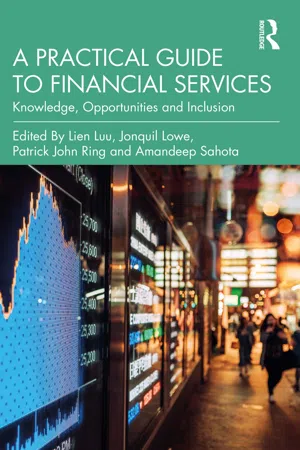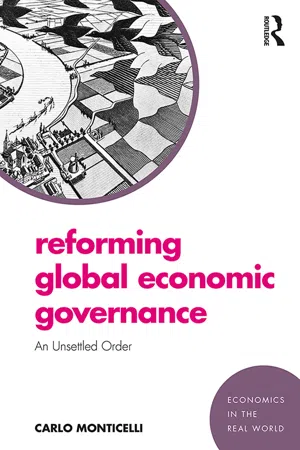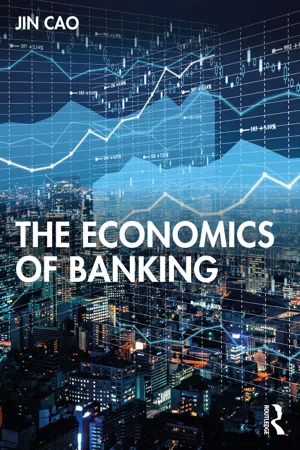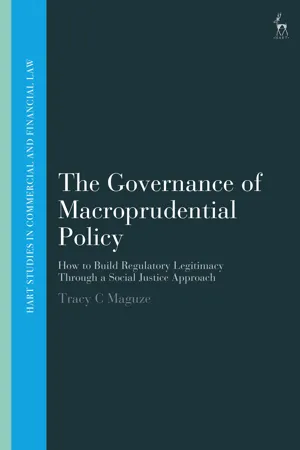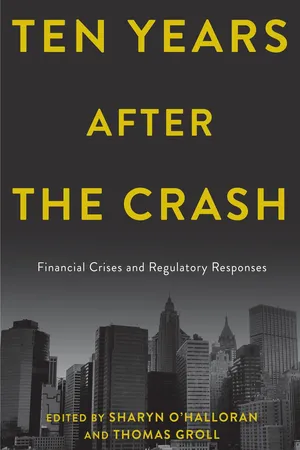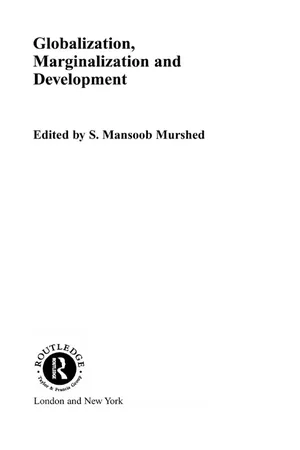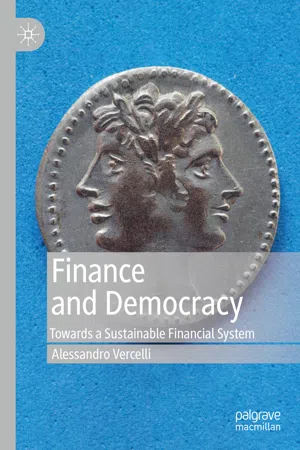Economics
Financial Regulation
Financial regulation refers to the rules and laws that govern the operation and activities of financial institutions and markets. Its primary goal is to maintain stability, protect consumers, and prevent financial crises. This regulation encompasses a wide range of areas, including banking, securities, insurance, and market conduct, and is enforced by government agencies and international organizations.
Written by Perlego with AI-assistance
Related key terms
Related key terms
1 of 4
Related key terms
1 of 3
12 Key excerpts on "Financial Regulation"
- eBook - ePub
Investment and Portfolio Management
A Practical Introduction
- Ian Pagdin, Michelle Hardy(Authors)
- 2017(Publication Date)
- Kogan Page(Publisher)
Authorization of companies or individuals will involve an element of thorough research into the background and history and may be dependent upon reaching a minimum level of qualifications or prescribed standards of conduct. The precise method and intensity of monitoring will depend upon the level of risk posed by the company or individual, the perceived likelihood of breaching the rules/regulations, the potential consequences of a breach in the rules/regulations and the supervising agency’s resources. Any enforcement procedures may occur for a variety of reasons including the supervisor’s monitoring activities, or a complaint by a customer or another market participant. Enforcement procedures would usually involve some form of investigation to determine exactly what has occurred, the root cause and if further action or sanction is required. The supervising agency may employ the use of enforcement officers with powers to investigate and to gather information. It may be that there is an agency which is appointed with the responsibility for monitoring compliance and the identification of suspected rule breaking, but a separate agency has the responsibility to determine if the suspicion is proven and if so, to apply an appropriate penalty, sanction or impose compensation.Regulation in financial markets
It is generally accepted that the operations of the financial markets are pivotal in the development of any economy and the financial sector is the mechanism which facilitates the exchange of goods and services in the economy and to transfer the savings of an economy into investments. A sound, efficient and well-managed financial sector will accomplish this process, encouraging more savings and therefore more investment in the process. This should result in faster economic growth, improved levels of income and therefore the end result should be the improvement of well-being domestically, within the economy. Strong and efficient domestic financial markets may also be of significant benefit to global growth in the form of investment capital movement from wealthier, more developed economies, to emerging and developing economies.It has been mentioned earlier in the chapter that one of the reasons for robust regulatory regimes being so important is the issue that information asymmetry exists, within the finance sector, between the sellers of financial products and the buyers. Generally, most markets work well when there is a high frequency of repeat purchases of a given product, because in these market circumstances, it is quite straightforward for an individual to determine the inherent quality of the product. It is also easy for the individual to switch away from a poor quality product to a product of better quality and not to make the same error in the future. - eBook - ePub
- Kirsten Bindemann(Author)
- 2002(Publication Date)
- Routledge(Publisher)
10 . Arbitrage in turn creates efficient market prices. The wider the definition of integration, the wider the degree of efficiency and innovation (Steil 1992). This leads to increased competition among markets and trading systems.Finally, regulators should aim at fairness, which Kenneth Berrill11 defined as ‘protecting Aunt Agatha’. What he means by this is that small investors should have the same access, information, and protection as large, often institutional, investors.In summary, the main objectives of financial market regulation are the reduction of systemic risk, the enhancement of market efficiency, and the promotion of fairness in market operations. We will now discuss the different types of regulation that aim to enforce the above mentioned objectives.Forms of regulation
We can distinguish three types of financial market regulation: structural, prudential, and investor protection regulation. All three forms have the objective to stabilise the financial system by ensuring the soundness and safety of financial institutions, to safeguard the efficiency of markets in terms of both the services provided and the products traded, to protect investors, and to maintain the functioning of the payments system. Below, we briefly outline each type, starting with structural regulation.Structural regulation is concerned with the main types of activities which financial institutions are permitted to engage in. It sets out the conditions for the establishment of new institutions and the branching out of exiting ones. Thus, a high degree of structural regulation would severely limit the level of activities that financial institutions may pursue. On the other hand, if the regulators envisage greater competition among firms they will lighten structural regulation. The latter case, structural deregulation, has been observed during the 1980s and 1990s. Take the UK as an example. Building societies are now permitted to engage in retail banking activities. Banks have ventured into stockbroking and the sale of insurance policies, and so forth. As a consequence, the boundaries between different classes of financial institutions have been blurred. - eBook - ePub
A Practical Guide to Financial Services
Knowledge, Opportunities and Inclusion
- Lien Luu, Jonquil Lowe, Patrick Ring, Amandeep Sahota, Lien Luu, Jonquil Lowe, Patrick Ring, Amandeep Sahota(Authors)
- 2021(Publication Date)
- Routledge(Publisher)
11 Regulation of financial services Patrick John RingDOI: 10.4324/9781003227663-11Key points summary- There are three objectives of Financial Regulation: systemic stability, the soundness of individual firms and ensuring that markets work effectively (including appropriate consumer protection). The objectives and theory about how they may be achieved influence the structure of regulation.
- The main front-line tasks for regulators are to authorise appropriate firms to do business, police the perimeter between authorised and unauthorised firms and supervise and enforce compliance with specified rules.
- Consumer protection can take two forms: ex-ante protection focuses on preventing consumer detriment; ex-post protection provides routes for complaints and redress.
- Conventional regulatory measures may be supplemented with innovative approaches, such as ‘nudging’ consumer behaviour and trying to change the culture of firms.
It is fair to say that, in recent years, events in the financial sector have cast a strong light upon the role of national and international regulators of the financial services industry. The Global Financial Crisis (GFC) that started in 2007 – described in Box 1.1 in Chapter 1 – drew attention to the failures of Financial Regulation, and subsequent financial scandals in many different countries have also drawn attention both to the challenges faced by consumers in navigating their way through an increasingly complicated financial landscape, and to the behaviour of certain individuals and the culture of the firms for which they worked.In this chapter, we begin by looking at the objectives of Financial Regulation and how that can influence the structure of national regulators. Thereafter, we focus upon the position in the UK, which itself illustrates many of the issues and dilemmas facing regulators around the world. In doing so, we concentrate on three particular issues: the regulatory concerns of front-line regulation, the role of regulators when it comes to the protection of financial services consumers and the regulation concerning the behaviour of individuals and culture of financial firms operating within the financial services sector. - eBook - ePub
Reforming Global Economic Governance
An Unsettled Order
- Carlo Monticelli(Author)
- 2019(Publication Date)
- Routledge(Publisher)
Conventionally, the international standards relevant to financial stability are grouped into three areas. The first one regards the transparency of macroeconomic policies and data. It includes principles that should be adhered to in: i) compiling and disseminating economic, financial, and socio-demographic harmonized statistics; ii) adopting practices so as to provide a clear picture of the structure and finances of government; iii) ensuring transparency in the conduct of monetary and financial policies; and iv) producing and disseminating information in order to access international capital markets. 5 The second area focuses on Financial Regulation and supervision, and covers standards to define the framework for: i) the supervision of the insurance sector; ii) the sound prudential regulation and supervision of banks and banking systems; and iii) securities regulation protecting investors, reducing systemic risk, and ensuring that markets are fair, efficient, and transparent. 6 The third area covers institutional and market infrastructure, and comprises standards defining: i) independent auditors’ responsibilities; ii) the legal, institutional, and regulatory framework that influences corporate governance; iii) benchmarks to assess the quality of deposit insurance systems; iv) the features of systemically important payment systems, central securities depositories, securities settlement systems, central counterparties, and trade repositories as well as the responsibilities of the respective supervising authorities; v) the legal, regulatory, and operational measures for combating money laundering and the financing of terrorism; vi) ways to evaluate and improve insolvency and creditor/debtor regimes; and vii) a single set of accounting standards to be applied on a globally consistent basis. 7 On the other hand, if the international standards regime complemented by a pivotal forum bringing together the - eBook - ePub
- Jin Cao(Author)
- 2021(Publication Date)
- Routledge(Publisher)
PART IV The economics of banking regulationPassage contains an image
CHAPTER 11 Systemic risks and macroprudential regulation
DOI: 10.4324/9780429356773-1511.1 Introduction
11.1.1 Why Is Banking Regulation Special?
Banks, as firms in other industries, are subject to regulation. Compared with other industries, banks are rather heavily regulated, for reasons which are probably obvious. As we have shown in the previous chapters, banks eliminate financial frictions and improve social welfare, and banks also create failures that cannot be solved by themselves. Therefore, in principle, regulation is needed wherever banks fail to discipline themselves: regulators must create and enforce the rules of game for all banks, making sure that all banks comply with legal requirements on their businesses; regulators must prevent banks from abusing their market power to extort their competitors and customers, as well as maintain necessary market competition; regulators must correct market failures due to asymmetric information as well as punish fraud and deception, and so on.However, compared with regulation in other heavily regulated industries such as telecommunications, banking regulation is also made different, by special characteristics in financial intermediation and the strategic status of banking industry in the economy. Banking regulation is particularly distinguished by several features:- The main outcome of banking regulation is an extremely desirable public good: financial stability. As banks are among main providers of financial resources to the real economy, a well-functioning banking system is a foundation for a well-functioning economy. As is shown in Chapter 8
- eBook - ePub
The Governance of Macroprudential Policy
How to Build Regulatory Legitimacy Through a Social Justice Approach
- Tracy C Maguze(Author)
- 2024(Publication Date)
- Hart Publishing(Publisher)
This chapter has attempted to demonstrate that the nature and magnitude of financial market failures necessitates government intervention in financial markets. However, before intervening, it is critical to identify and calibrate appropriate regulatory solutions because badly designed regulations are likely to cause just as much harm as financial market participants.The way the financial system generates risk, the speed at which this risk migrates across the system (between banks and non-banks alike), and the inadequacy of pursuing financial stability via the safety and soundness of individual institutions suggest that regulations for financial stability should have a different objective, specifically the maintenance of the safety and soundness of the whole system, and ultimately avoid costs to the broader economy.A regulator with a bird’s-eye view of the financial system would require tools that can be calibrated at macro level. Moreover, the tools should be able to tackle the cross-sectional and time dimensions of financial instability. In other words, they should work to reduce interconnections and common exposures to macro risk, while at the same time operating in a countercyclical manner to dampen exuberance during an upswing, but still provide a cushion that allows banks to continue operating should a downswing occur. This is not to say that policy makers should reinvent the wheel and devise completely new tools, current tools in the prudential armoury may suffice if appropriately calibrated and deployed.After the GFC, the world turned to macroprudential policy to fill the gap left by microprudential regulation. Macroprudential policy, as already stated in Chapter 1 - eBook - ePub
- Andreas Kokkinis(Author)
- 2017(Publication Date)
- Routledge(Publisher)
It is evident from the discussion in this chapter that profitable risk-taking by individual financial institutions often harms the stability of the financial system, and hence the overall economy, and that there is, therefore, a strong public interest in safeguarding the public good of financial stability. Prudential regulation, mostly of banks, but recently also of other major financial institutions, has been the public law response to this problem, while the corporate law regime applying to financial institutions had been – until a decade ago – excluded from the scope of prudential regulation in tandem with the regime applicable to any other large public company. In the two chapters that follow, we will see that post-crisis regulatory reforms have had a significant impact on the corporate law framework for financial institutions, although the two areas of law have maintained their formal autonomy.1 For a general discussion of banking regulation and supervision globally, see James Barth, Gerard Caprio Jr and Ross Levine, Rethinking Bank Regulation: Till Angels Govern (CUP, 2006).2 David Llewellyn, ‘The Economic Rationale for Financial Regulation’ (FSA Occasional Paper Series 1, April 1999), 10 www.fsa.gov.uk/pubs/occpapers/op01.pdf accessed 1 May 2017.3 See Markus Brunnermeier and others, The Fundamental Principles of Financial Regulation: Geneva Reports on the World Economy 11 (Center for Economic Policy Research, 2009), ch 3.4 For a discussion of the economic rationales for Financial Regulation, see Llewellyn (above n 2). A brief discussion on why banks should be regulated can be found in Kenneth Spong, Banking Regulation: Its Purposes, Implementation and Effects (5th edn, Federal Reserve Bank of Kansas City Publications, 2000), 5–13.5 For an in-depth analysis of the lender of last resort function of the Bank of England, its history and its recent evolution, see Andrew Campbell and Rosa Lastra, ‘Revisiting the Lender of Last Resort – The Role of the Bank of England’ in Iain MacNeil and Justin O’Brien (eds), The Future of Financial Regulation (Hart Publishing, 2010), esp 161–170.6 On the limits of deposit protection, see above Chapter 1 , n 80 and accompanying text. For a critical discussion of the relationship between deposit protection and moral hazard, see Jenny Hamilton, ‘Depositor Protection and Co-insurance after Northern Rock: Less a Case of Moral Hazard and More a Case of Consumer Responsibility?’ in Johanna Gray and Orkun Akseli (eds), Financial Regulation in Crisis? The Role of Law and the Failure of Northern Rock - eBook - ePub
- John Eatwell, Terry McKinley(Authors)
- 2016(Publication Date)
- Routledge(Publisher)
Amongst the public actors we can distinguish regulators, central bankers, governments and sovereign funds. Government funding on markets became more and more important during the last years. They will play a major role in the resolution of the current euro-crisis. Sovereign wealth funds manage public money raised through exports. Their main objective is often to substitute financial rent for the existing rent based on commodities exports (Middle eastern oil producers, Russia, Norway etc) or growing balance of payments surpluses (China). Central banks must widen their responsibilities to deal with financial instability and redefine the extent of their function of lender of last resort. A first approach considers that monetary stability and financial stability have both to be dealt with by central banks. However, following the economic principle that available instruments have to be paired with the objectives for which they are the most effective, a second approach recommends assigning price stability to central bank and financial stability to an independent regulatory authority. Regulators will play a determinant role in shaping financial markets. The heterogeneous perceptions of danger can lead to very different regulatory responses to the risk (Douglas, 1986) and lead to the emergence of new forms of finance based on alternative principles of risk management. Depending on the degree of cooperation between national regulators and on their capability to move from their national preferences, we could either get a unified regulatory system at the regional/global scale or purely national rules which apply only in the jurisdiction. In the future alternative forms of risk management and regulation may be developed in the different regions of the world following the cultural preferences. We can envisage the development of different ethics of finance as exemplified with Islamic financial products - eBook - ePub
After the Crash
Financial Crises and Regulatory Responses
- Sharyn O'Halloran, Thomas Groll(Authors)
- 2019(Publication Date)
- Columbia University Press(Publisher)
finance is a shape-shifter. Regulatory arbitrage is endemic, and the rule-writers end up chasing their tails.By this way of thinking, the great financial crisis was waiting to happen. That it was triggered by the relatively small U.S. subprime mortgage market revealed that the system’s resilience was wafer thin. It had been eaten away over the preceding years by the dynamics of the system itself.At first blush, then, societies seem to face a clash between, on the one hand, the rule-of-law values of predictability and generality described earlier and, on the other hand, the welfare of the people. But it is not quite so straightforward. The value of predictability is thrown into doubt when rules (predictably) fail to achieve their public policy objective. As the Systemic Risk Council has put it:Those are very much among the goods that drove Hayek’s attachment to predictability and transparency. Judgment-Based Prudential SupervisionThe resilience of national financial systems is a vital good, essential for citizens to live decent lives. It is necessary for individuals, families, businesses, and entrepreneurs to be able to plan for the future, transact with each other, and commit their savings to new ventures.19Stability policy accordingly confronts the issue around rules versus standards in a particular way. To repeat, a compliance-based approach of identifying and punishing rule breaches after the financial system has imploded, creating economic havoc, does not exactly rise to the seriousness of the stability mission.Where generalized rulelike quantity constraints are placed on intermediary balance sheets to induce them to internalize social costs or self-insure beyond their (perception of their) private interests, those requirements likely need tailoring to the specific cost and risk structures of each intermediary, and to their significance to the system being able to maintain the provision of core services in adverse circumstances. In the language of prudential supervisors, this would cover both Pillar 2 and “systemic surcharge” requirements. It is a form of regulation that requires deep knowledge of and judgments about each relevant intermediary. Further, the micro-supervisor has to be ready and able to make judgments of the following kind: - eBook - ePub
- Mansoob Murshed(Author)
- 2002(Publication Date)
- Routledge(Publisher)
2 Financial sector regulation in a globalized context
S. Mansoob Murshed and Djono SubagjoIn his presidential address to the American Economics Association, Milton Friedman gave us the authoritative version of the monetarist creed:…monetary policy can prevent money itself from being a major source of economic disturbance… A second thing monetary policy can do is to provide a stable background for the economy. Milton Friedman (1968: 12–13)This statement has become the cornerstone of macroeconomic policy advice dispensed to all developing and transitional economies. It also constitutes the raison d’être for the primacy of inflation control, as well as the stabilization and structural adjustment programmes of the 1980s, and the associated liberalization of financial markets. But as we all know, with hindsight, this view (generally described as the Washington consensus) ignored the need for prudential regulation of the financial sector as a prerequisite for sound monetary policy. The converse is equally true: stable monetary policies are needed if an efficient financial sector is to flourish. Simple (or simple-minded) capital account liberalization, as part of a strategy of integration into the global economy, has become discredited in the wake of the Asian crisis of 1997 (see Rodrik 1998). In addition, it is recognized that monetary policy reform geared to controlling inflation will not benefit the economy fully unless and until the private financial sector is well functioning. Also in the presence of many other distortions in the economy, financial liberalization may be undesirable, due to second-best considerations. The over-arching problem lies in the weak nature of institutions and the type of strategic interaction between the state and various groups in developing countries (LDCs).This chapter aims to make a policy-oriented contribution to the literature on prudential bank regulation for LDCs. It does three things: first, it argues that there is a need to place banking sector regulation high on the policy agenda. Second, it provides some theoretical insights, emphasizing the difficulties of the regulation process. Finally, it critically analyses policy advice in a taxonomic style with regard to prudential regulation, paying close attention to the capabilities of lowincome and small LDCs. The first section examines the need to pay attention to banking regulation, the second section is devoted to the theoretical and policy analysis on bank regulation, and, finally, the third section concludes with policy recommendations. - eBook - ePub
Fintech, Small Business & the American Dream
How Technology Is Transforming Lending and Shaping a New Era of Small Business Opportunity
- Karen G. Mills(Author)
- 2019(Publication Date)
- Palgrave Macmillan(Publisher)
Principles for U.S. Financial Reform
For the good of America’s small businesses , we must move on from the polarized view that any new financial regulation is bad for industry and consumers, as well as the opposing view that financial firms are untrustworthy, and must have ever-more rules piled upon them. In their 2003 book, Saving Capitalism from the Capitalists , Raghuram Rajan and Luigi Zingales make the argument that protecting free markets requires government intervention.25 Governments need to guarantee property rights for the large and small alike to ensure that incumbents don’t use their political advantage to benefit themselves, but also to provide a safety net for those who are the losers from economic displacement. The authors also suggest that too much government regulation of finance can actually benefit incumbents and insiders rather than encourage dynamic markets and benefit consumers and investors. Balance is the key.Innovation has made its way into financial services, and the changes technology will bring to products and markets will continue. The entry of platforms and the more pervasive use of data and artificial intelligence are likely to impact lending markets dramatically. The Basel Committee on Banking Supervision summarized the moment: “fintech has the potential to lower barriers of entry to the financial services market and elevate the role of data as a key commodity, and drive the emergence of new business models. As a result, the scope and nature of banks’ risks and activities are rapidly changing and rules governing them may need to evolve as well. These developments may indeed prove to be more disruptive than previous changes in the banking industry, although as with any forecast, this is in no way certain.”26 Change is coming, and our regulatory system is not yet prepared to meet these challenges.Remaking the U.S. financial regulatory system will be difficult, but we should make our best attempt to be proactive. The answer is not more or less regulation, but the right regulation —balanced, sensible rules that operate in a transparent environment. It is time for an active agenda of financial regulatory reform in small business lending that is guided by three broad principles: (1) supporting innovation ; (2) enhancing protections for small business - eBook - ePub
Finance and Democracy
Towards a Sustainable Financial System
- Alessandro Vercelli(Author)
- 2019(Publication Date)
- Palgrave Macmillan(Publisher)
However, the actual accounting record is inconsistent with these harsh complaints since “banks and their parent-companies, regardless of size, saw their profits increase steadily during the entire time after the Dodd-Frank Act was passed in 2010. In 2016 alone, banking institutions earned a total of $175 billion in net profits” (Omarova 2017, 2). 31 In any case, the imposition by regulation of additional private costs has always been the principal instrument to protect the public from potential harm caused by profit-seeking private agents: “Child labor laws, environmental regulations, anti-fraud rules all raise costs of doing business for those private firms that stand to profit from activities the society deems undesirable” (Omarova 2017, 6). In economics and finance, the main rationale for public regulation is the internalisation of the negative externalities brought about by unfettered markets. The orthodox theory of competitive markets developed this approach long ago. 32 In this view, we have to internalise the negative externalities of a certain industry (such as pollution, financial instability, and social distress) by increasing the costs of its products or services in such a way to take account of the external costs imposed on the public. After the Great Recession, no one can doubt that the costs imposed by the financial industry on society are huge. The compliance costs and the foregone profits of regulation are unlikely to have the same order of magnitude of the huge costs imposed by finance on society in recurring crises. As for the employment, in the financial sector the elasticity of supply of financial products and services is much higher than in other sectors of the economy
Index pages curate the most relevant extracts from our library of academic textbooks. They’ve been created using an in-house natural language model (NLM), each adding context and meaning to key research topics.
Explore more topic indexes
Explore more topic indexes
1 of 6
Explore more topic indexes
1 of 4


